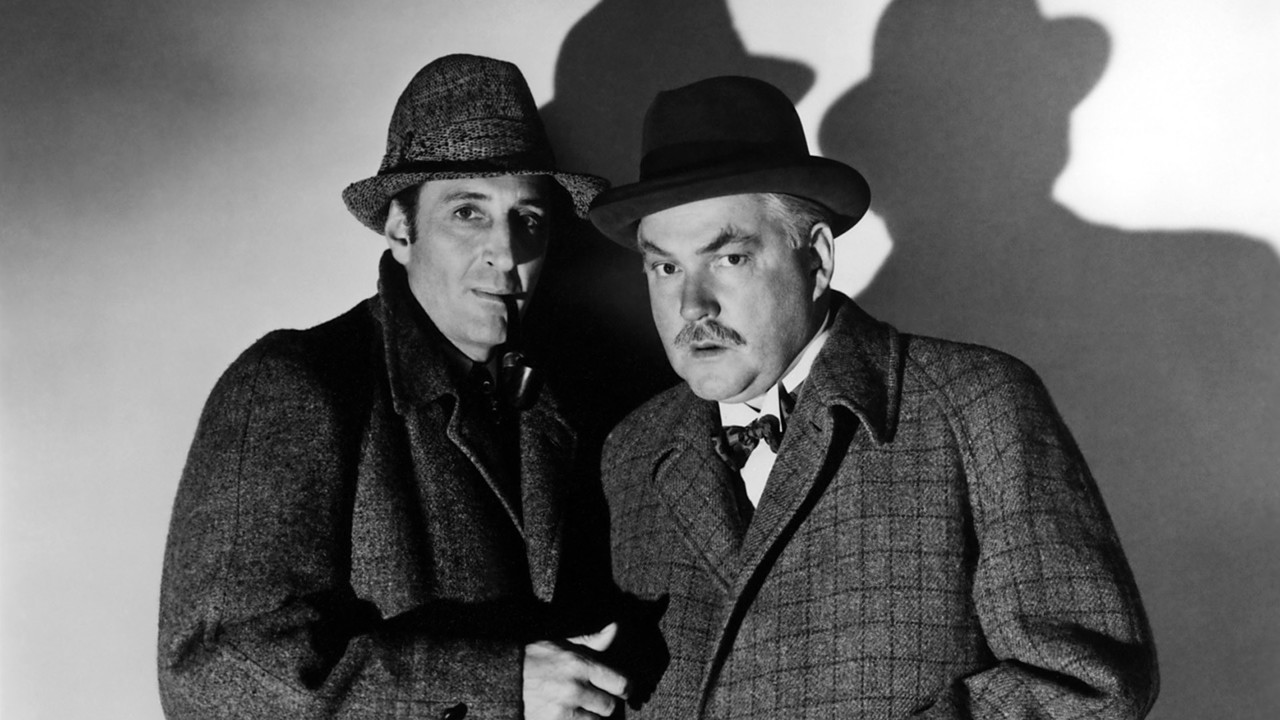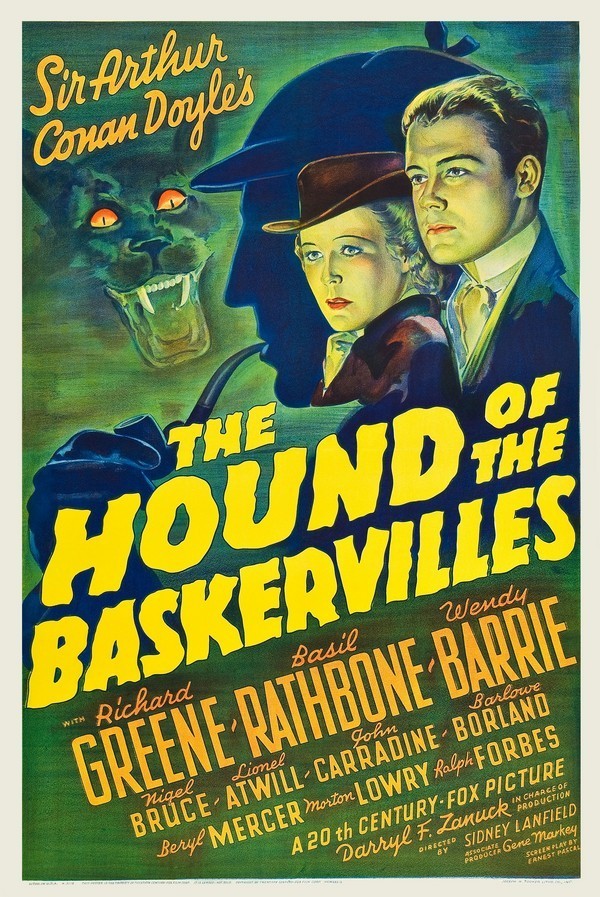Crew
Director – Sidney Lanfield, Screenplay – Ernest Pascal, Based on the Novel The Hound of the Baskervilles (1902) by Arthur Conan Doyle, Producer – Darryl F. Zanuck, Photography (b&w) – Peverell Marley, Music Supervisor – Cyril J. Mockridge, Art Direction – Richard Day & Hans Peters. Production Company – 20th Century Fox.
Cast
Basil Rathbone (Sherlock Holmes), Nigel Bruce (Dr Watson), Richard Greene (Sir Henry Baskerville), Wendy Barrie (Beryl Stapleton), Lionel Atwill (Dr James Mortimer), Morton Lowry (John Stapleton), John Carradine (Barryman), Barlowe Borland (Frankland), Beryl Mercer (Jennifer Mortimer)
Plot
Following the death of Sir Charles Baskerville on the Dartmoor Baskerville estate, Sherlock Holmes receives a visit from a friend of the Baskerville family who is dissatisfied with the coroner’s official verdict. It is reputed that the descendants of the Baskerville family are all fatally haunted by a giant hound because of the misdeeds of a 17th Century ancestor. The latest Baskerville descendant Sir Henry arrives to accept his inheritance and immediately becomes the subject of mysterious doings as a ghostly hound is spotted on the moors. Sherlock Holmes goes undercover to ascertain the agency behind this.
The Hound of the Baskervilles was the first in a long-running series of Sherlock Holmes adaptations starring Basil Rathbone and Nigel Bruce. 20th Century Fox next made the superb The Adventures of Sherlock Holmes (1939), the very best of the Basil Rathbone Sherlock Holmes films. Fox then abandoned the series only to see Basil Rathbone and Nigel Bruce taken up three years later over at Universal for a further twelve wholly mediocre films, which ignominiously transported Holmes out of his quintessential Victorian setting and into the present day. These consisted of Sherlock Holmes and the Voice of Terror (1942), Sherlock Holmes and the Secret Weapon (1942), Sherlock Holmes in Washington (1943), Sherlock Holmes Faces Death (1943), The Spider Woman (1944), The Scarlet Claw (1944), The Pearl of Death (1944), The House of Fear (1945), The Woman in Green (1945), Pursuit to Algiers (1945), Terror By Night (1946) and Dressed to Kill (1946).
Arthur Conan Doyle’s The Hound of the Baskervilles (1902) seems an odd choice to start a series with. It is a logical choice in that it is one of the handful of novel-length Sherlock Holmes adventures but it is also a story in which by any faithful telling the central character of Holmes is absent for nearly half the story. (Oddly enough though, The Hound of the Baskervilles remains the most popular of all Sherlock Holmes stories in film adaptations – see below for other screen versions).
There is an uncertainty about the adaptation here – perhaps it is that 20th Century Fox had no established cinematic English-language Holmes milieu to draw upon up to that point – and Sidney Lanfield seems caught between directing it as a gangster film and a horror film. The uncertainty is even evident in the cast list, which places boyish romantic lead Richard Greene who plays Sir Henry above the name of Basil Rathbone who plays Holmes.

The clues seem irrelevant and the exposition of the mystery takes place in several static pieces of stodgy extract. However, the film has considerable atmosphere in its seances, fog-bound moor scenes and hansom cab pursuits. The moors have a moody gloominess, although ultimately are obviously stagebound. Basil Rathbone and Nigel Bruce make a good pairing, the lean bony-faced Rathbone projecting a keen intellectual fascination and having clear fun when it comes to the disguises. Nigel Bruce perfects his jolly porridge of a Watson, a role that he turned into a reliable comic prop throughout the rest of the series.
This is enjoyable adaptation but better versions of the story have been made, particularly the 1959 Hammer version and the feature-length tv version made in 1988 by Granada as part of their The Adventures –, The Return –, The Casebook – and The Memoirs of Sherlock Holmes series (1984-94), as well as the 2002 tv movie. In other versions of the story, there was a series of six German films released under the same title between 1914 and 1920, which were made by two different companies when one director defected and both companies kept making rival sequels. These soon abandoned the Arthur Conan Doyle material and developed the story out like a complex serial, even going back into the history of the Baskerville family. One of the directors Richard Oswald attempted a further German remake with the standoutThe Hound of the Baskervilles (1929). Other versions include a lost silent French version The Hound of the Baskervilles (1914); the first American version, the silent The Hound of the Baskervilles (1920) with Ellie Norwood; a lost British sound version The Hound of the Baskervilles (1931), written by thriller writer Edgar Wallace; another German version The Hound of the Baskervilles (1936); the celebrated Hammer version The Hound of the Baskervilles (1959) with Peter Cushing as Holmes and Christopher Lee as Sir Henry; a two-part adaptation as part of the tv series Sherlock Holmes (1964-8) also starring Peter Cushing; a tv adaptation The Hound of the Baskervilles (1972) with Farley Granger as Holmes; the unfunny comedic version The Hound of the Baskervilles (1978) with Peter Cook and Dudley Moore respectively as Holmes and Watson; a six-part BBC mini-series adaptation The Hound of the Baskervilles (1982) with Tom Baker as Holmes; The Hound of the Baskervilles (1983) with Ian Richardson; a routine Canadian-made tv movie The Hound of the Baskervilles (2000) with Matt Frewer miscast as Holmes; and an excellent British tv version The Hound of the Baskervilles (2002) with Richard Roxburgh as Holmes. The story was also given an interesting modernisation in the BBC’s Sherlock (2010– ) tv series, which set it around a bacteriological research facility, and in the Hounded (2016) episode of Elementary where it is set around the murder of a financier by a ghostly hound. This version of the film was considered incomplete by Holmes-ophiles until 1975 when a print was uncovered that contained Holmes’s originally censored line “The needle, Watson.”


